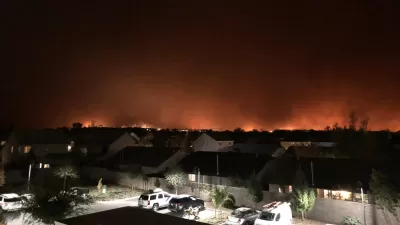The state’s housing shortage is complicated by the growing number of places threatened by wildfires.

California must carefully balance its dire need for more housing with the risks posed by increasingly destructive wildfires which should discourage communities from building in fire-prone areas, writes Dan Walters for CalMatters.
“The friction between those two imperatives is played out in the political arena, where officialdom makes land use policy.” After Governor Gavin Newsom vetoed a bill that “would have required local governments to make fire safety a major factor in approving housing developments in fire-prone areas by compelling developers to include protective features,” claiming it would have allowed cities to avoid meeting their housing mandates, state Attorney General Rob Bonta has taken a series of steps to prevent further development in the wildland-urban interface.
In a set of guidelines released this week, Bonta writes that it is “imperative that local jurisdictions making decisions to approve new developments carefully consider wildfire impacts as part of the environmental review process, plan where best to place new development, and mitigate wildfire impacts to the extent feasible.”
To Walters, “The issue demands something more definitive than a document from the attorney general. Newsom and the Legislature should, as they ramp up pressure for more housing construction, also delineate where it should — and should not — occur.”
FULL STORY: California faces a housing/wildfire conundrum

Planetizen Federal Action Tracker
A weekly monitor of how Trump’s orders and actions are impacting planners and planning in America.

Map: Where Senate Republicans Want to Sell Your Public Lands
For public land advocates, the Senate Republicans’ proposal to sell millions of acres of public land in the West is “the biggest fight of their careers.”

Restaurant Patios Were a Pandemic Win — Why Were They so Hard to Keep?
Social distancing requirements and changes in travel patterns prompted cities to pilot new uses for street and sidewalk space. Then it got complicated.

California Homeless Arrests, Citations Spike After Ruling
An investigation reveals that anti-homeless actions increased up to 500% after Grants Pass v. Johnson — even in cities claiming no policy change.

Albuquerque Route 66 Motels Become Affordable Housing
A $4 million city fund is incentivizing developers to breathe new life into derelict midcentury motels.

DC Area County Eliminates Bus Fares
Montgomery County joins a growing trend of making transit free.
Urban Design for Planners 1: Software Tools
This six-course series explores essential urban design concepts using open source software and equips planners with the tools they need to participate fully in the urban design process.
Planning for Universal Design
Learn the tools for implementing Universal Design in planning regulations.
Heyer Gruel & Associates PA
JM Goldson LLC
Custer County Colorado
City of Camden Redevelopment Agency
City of Astoria
Transportation Research & Education Center (TREC) at Portland State University
Camden Redevelopment Agency
City of Claremont
Municipality of Princeton (NJ)





























